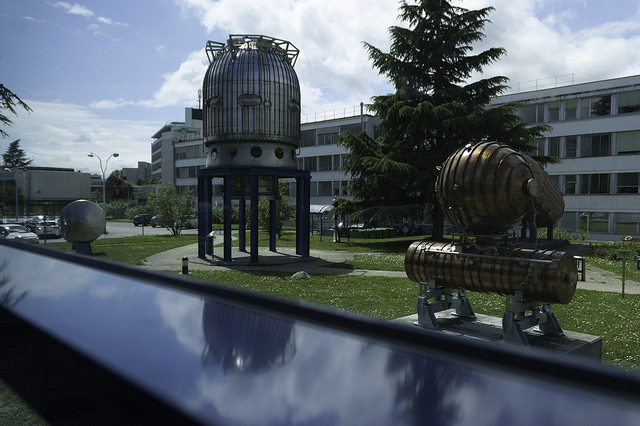

This is part of our feature Transformation of Higher Education and Research in Europe.
Global research collaboration and competition plays an increasing role in everyday life of contemporary academia. Researchers submit their articles to international peer-reviewed journals in an effort to publish their novel findings faster than competitors. Increasingly, these papers are co-authored in collaboration with peers from other countries. Scholars broaden their horizons and learn new skills during their research visits to foreign universities and by welcoming visiting researchers in their own “home” institutions. Universities aim to attract the best minds from around the globe by offering them better research conditions than competitors. Research institutions create international consortia to compete for funding to tackle global problems. Scientists regularly present their recent research in conferences of international scientific societies that play an important role in defining their professional identities and quality standards.
Already for centuries, international collaboration and competition has played an important role in the creation and circulation of new knowledge. Moreover, processes of research collaboration and competition are closely interconnected. Robert Merton’s (1973 [1942]) hybrid notion of “a competitive cooperation” captures this interdependence. Today global research collaboration and competition is intensifying (Wagner et al 2015) for many reasons: increasing scientific specialization, growing complexity of research, need to address cross-border problems, escalating costs of research equipment, advancement of information and communication technologies, and increasing role of quantitative evaluations such as global university rankings. Collaboration and competition can take many forms. Collaboration includes co-authored publications, participation in research consortia or large-scale research facilities such as European Organization for Nuclear Research (CERN), and contribution to scientific societies, networks, and conferences. At the same time, researchers and universities compete for priority of discovery, prestige, reputations, best researchers, and funding.
My research on international scientific collaboration (Ulnicane 2015) in five European countries—Germany, France, Netherlands, Belgium, and United Kingdom—reveals that collaboration and competition can have positive as well as more problematic aspects. These aspects were explored in depth by combining diverse methods and data sources including longitudinal case studies of international research collaborations, project, publication, and citation analysis, 61 interviews with collaborating scientists, and visits to 31 research institutes. Global research collaboration and competition differs considerably across disciplines and research fields. Here an emerging field of nanosciences and technologies was studied where, in recent years, collaboration and competition has been particularly active. While some insights are specific for laboratory sciences, many findings are similar to developments in other disciplines including social sciences.
Bright side: more and faster cutting-edge research
Global collaboration allows researchers to do more and higher impact research (Wagner et al 2015) because it enables bringing together highly specialized and high quality competencies, combining them in novel ways, and increasing the speed of research due to joint effort. A successful collaborator explains that working with scientists that have complementary expertise helps doing frontier research and increasing their research productivity:
The first motivation [for international collaboration] is that each one is limited. I cannot do everything, I cannot know everything and I feel that specialising on one or another topic is a solution to do things at the frontier. And so according to this I need to collaborate with people in order to complement what is our activity and it is also a way somehow for us to learn something new, to go beyond our limit. […] We are limited in terms of creativity. We are limited in terms of the activity we can do. The combination of different minds allows to do something new, to go further.
Additionally, scientists emphasize that international collaborations facilitate research creativity and problem-solving capacities by bringing together different mind-sets, ways of thinking, and mentalities:
If you have one [scientific] problem and you take a look at the problem from your own point of view, it is very easy to get stuck. If you really want to keep your flexibility in science you should take a look at a problem from different angles, different perspectives and part of it is that you should also learn how the mind-set works for other people.
While collaborators often talk about the importance of developing common language, they also value novelty of interacting with scientists that pursue different approaches and perspectives. A leading scientist sees such encounters as a source of scientific innovation:
Talking to people outside your comfort zone is very good. Trying to communicate with someone, who sort of speaks a different science language, is good. This sort of stumbling around can throw up ideas, and sometimes you say things which you feel are very silly but it does not matter in that sort of sense that you lose ambition. [This] can be very creative.
From a practical point of view, international collaboration can also be a way to access additional resources. At times when the share of institutional funding is decreasing and the role of the project-based funds is growing, collaborative international projects such as the EU Framework Programme represent an important funding source for many research groups. It can enable expansion of research by providing additional funds for research equipment and personnel even in research institutions where the share of institutional funding is still high. A research group leader who works in a research field with high equipment and material costs in a well-funded institute, where institutional funding constitutes around 80 percent of the budget, explains the importance of funds from collaborative projects in his context:
The budget [institutional funding] is not so bad but it could be better…and if you have let’s say one or two millions [Euros] extra it is more comfortable, especially for investments and finance some equipment, or finance additional PhD students.
Although global research collaboration and competition play an important role in facilitating research productivity and creativity, it can also involve problematic aspects.
Dark corners: power relations, project pressures and unreliable partners
Some critical discussions are related to allocation of credit for collaborative publications, as well as to high dependence on international project funding. Typical problems for allocation of credit for collaborative publications are excluding less powerful collaborators (junior researchers and female collaborators) who have contributed to publications, including (powerful senior) researchers who have not contributed to publications, and making decisions about the author order based on power relations, rather than actual contribution to research (Bozeman & Youtie 2015). These decisions have important implications for research careers and funding.
In Europe, some research groups are very dependent on highly competitive European research funding. They invest considerable time and resources for preparing collaborative applications for funding schemes with very low success rates, which is an increasing concern in EU research policy (Ulnicane 2016). A leader of a group that is mainly funded by the EU collaborative projects tells:
I consider if there is 10 percent success rate and, if I want to have one project, I set [the target] that each year I have to submit 10 [project applications]. Then there are some years that I am unlucky, I get zero. Some years that I am lucky, I get three [projects approved]. But more or less that is a number of projects we submit every year.
In some of these collaborative projects, he is a leader of the network, while in others he is one of participants. He sees these investments in preparation and managing of collaborative projects as instrumental for having a considerably larger [than would be possible with institutional and national funds] research group:
The reason why we have all these European projects is because we need funding to support ten people group but it is not my fun writing proposals. It is not my fun to manage a network. It is a means [to an end] but it is not my fun.
Due to pressure to acquire external funding, scientists might be less selective whether they are really familiar with and convinced about the competences and reliability of the project partners. Another scientist explains that the need to attract additional funding can lead to joining project applications with little-known partners and subsequently to inefficient short-term interactions:
The difficulties could be if in the project you do not know really well the group with which you are supposed to cooperate. So and then you force yourself into the project to work with them and then at the end the cooperation for sure is going to stop if you are not happy…you are working with people who are not really experts and once you did not really know it [in advance] then it would be hard to keep working with them.
Many scientists have negative experiences of collaborative projects, where some less known collaborators have turned out to be unreliable and endangered the success of the collaboration. That is especially case if—for some groups—funding is a sole motive for joining the project. A collaborator remembers an international project
Where people at the beginning promised to send material and even after 2-3 years nobody got anything…Later I learned that group which signed for it never really had a plan to send things. They were just playing games. They were harvesting the money, frustrating everybody, and only causing trouble in the network.
Problems can also arise when, in collaborative projects, junior researchers are not properly treated. While some funding schemes, such as the EU Marie Curie training networks, are specially designed for training early career researchers, their implementation can sometimes be difficult. A researcher tells that in one collaborative project,
There was one meeting for the young people, for the PhD students to complain to the project officer [from the European Commission] if there is anything to complain about, and some did. And afterwards their boss really criticized them very hard because they complained; they should not complain in front of the project officer. That was exactly the opposite from what should happen. He did not train them, he complained when they criticized.
In addition to problems with co-authorships and projects, intensifying global collaboration and competition also draws attention to urgent questions about inclusion of researchers from developing and catching-up countries, and about the “Matthew effect” when global collaboration and competition reinforces the power of leading universities, groups and research systems.
Conclusion: The role of policy
While global research collaboration and competition is strongly influenced by self-organization processes in the scientific community, policy plays an important facilitating or hampering role by providing funding, setting conditions, and defining rewards. One challenge for global collaboration is that most of research funding is provided at national level. Historically, much international collaboration was informal and supported by institutional funds, which are now decreasing. There is a relatively limited (but gradually increasing) number of funding schemes—such as the EU Framework Program—supporting international research collaborations. Researchers protest when funding schemes try to force them into “arranged marriages,” giving strong prescriptions with whom and how to collaborate. Collaborations tend to be more productive and creative when researchers can choose between variety of funding sources—institutional, national and international, basic and applied—allowing selection and combination of those that best fit their research aims and needs.
Inga Ulnicane is an assistant professor at the Institute for European Integration Research at the University of Vienna.
Photo: European Organization for Nuclear Research | Harald Felgner | Flickr
References
Bozeman, B., & Youtie, J. (2015). Trouble in Paradise: Problems in Academic Research Co-authoring. Science and Engineering Ethics, 1-27. doi: 10.1007/s11948-015-9722-5
Merton, R. (1973 [1942]). The Normative Structure of Science. In N. Storer & R. Merton (Eds.), The Sociology of Science. Theoretical and Empirical Investigations (pp. 267-278). Chicago: The University of Chicago Press.
Ulnicane, I. (2015). Why do international research collaborations last? Virtuous circle of feedback loops, continuity and renewal. Science and Public Policy, 42(4), 433-447. doi: 10.1093/scipol/scu060
Ulnicane, I. (2016). Research and Innovation as Sources of Renewed Growth? EU Policy Responses to the Crisis. Journal of European Integration, 38(3), 327-341. doi: 10.1080/07036337.2016.1140155
Wagner CS, Park HW, & Leydesdorff, L. (2015). The Continuing Growth of Global Cooperation Networks in Research: A Conundrum for National Governments. . PLoS ONE, 10(7). doi: 10.1371/journal.pone.0131816
Published on December 1, 2016.




